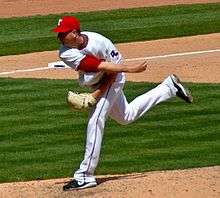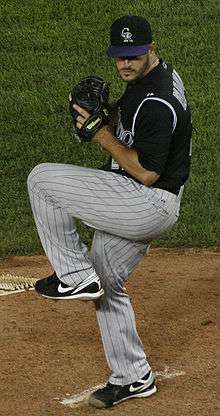Sinker (baseball)
In baseball, a sinker or sinking fastball is a type of fastball which has significant downward and horizontal movement and is known for inducing ground balls.[1] Pitchers who use the sinker tend to rely on it heavily and do not need to change pitch speeds as much as other pitchers do because the sinking action induces weak bat contact. Other pitchers normally change pitch speeds to achieve this effect.[2] The sinker is much more often used by right-handed than left-handed pitchers.
History

Before the 1950s, pitchers did not know what caused their pitches to sink or "hop." They regarded either ability as a "gift from heaven." Bill James cites Curt Simmons as the first pitcher to be able to throw both sinkers and rising fastballs, apparently indicating that it was not known how to make a pitch sink and how to make one hop.[1]
Current Major League pitchers
Zach Britton, Marcus Stroman, Charlie Morton, Dallas Keuchel, Jake Arrieta, Jim Johnson, Rick Porcello, Kendall Graveman, Sonny Gray, Jeurys Familia, Tanner Roark, Jordan Hicks, Sam Dyson, Scott Alexander, Dustin May, Matt Albers, Mike Soroka, and Mike Leake are current major league players who rely heavily on the sinker.
Throwing mechanics
One method of throwing the sinker is to simply grip the baseball along the two seams and throw it similar to a fastball. Some pitchers use a downward motion on their wrist when throwing it. The pitcher's palm turns to the right at release for a right handed pitcher. This causes a sharper sink, but also has a greater risk of a wild pitch. This wrist movement is also called pronation.
Many sinker ball pitchers today turn the inside of the ball over just before releasing the ball, combined with slightly increasing the pressure on the ball with the index finger ("press inside") which creates a tilted sidespin motion that causes horizontal movement.[1]
Effects on the batter
The sinker drops 6 to 9 inches more than a typical four seam fastball which causes batters to hit ground balls more often than other fastballs, mostly due to the tilted sidespin on the ball.[1] Horizontal movement also occurs when sinkers are thrown.[2] Sinkerball pitchers can often get called strikes and swinging strikes on the pitch.
Notable sinkerballers
- Bill Swift
- Greg Maddux
- Matt Albers
- Brad Bergesen
- Burke Badenhop
- Zack Britton
- Kevin Brown
- Trevor Cahill
- Aaron Cook
- Kevin Correia
- Jeurys Familia
- Scott Feldman
- Jon Garland
- Roy Halladay
- Roberto Hernández
- Orel Hershiser
- Chris Heston
- Luke Hochevar
- Tim Hudson
- Tommy John
- Jim Johnson
- Randy Jones
- Jeff Karstens
- Kyle Kendrick
- Dallas Keuchel
- Mike Leake
- Kameron Loe
- Mickey Lolich
- Derek Lowe
- Seth Maness
- Jason Marquis
- Justin Masterson
- Jackie Mitchell
- Sergio Mitre
- Charlie Morton
- Carl Pavano
- Brandon League
- Mike Pelfrey
- Carlos Silva
- Mel Stottlemyre
- Mike Timlin
- Blake Treinen
- Chien-Ming Wang
- Brandon Webb
- Randy Wells
- Jake Westbrook
- Jerome Williams
- Carlos Zambrano
- Juan Flores
- Scott Erickson
- Ronald Belisario
- Steve Cishek
See also
References
- John Walsh. "In Search of the Sinker". The Hardball Times.
- Joe P. Sheehan. "That Sinking Feeling". Baseball Analysts.
